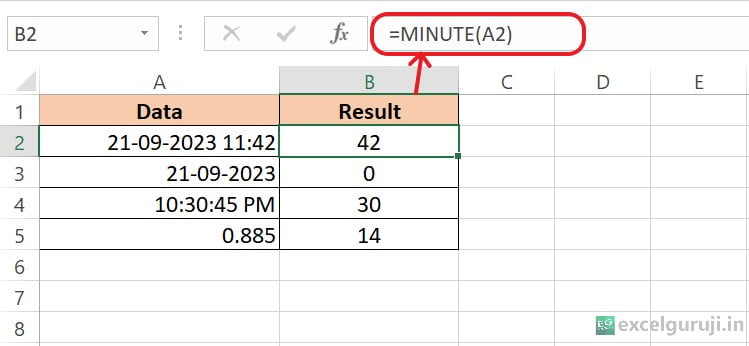Contents
Excel MINUTE Function

When to Use the Excel MINUTE Function in Excel
The Excel MINUTE function is a valuable tool when you need to work with time data in Excel. It allows you to extract the minutes portion from a time value. For instance, if you have a time of 9:10:15 PM, using MINUTE will yield the value 10.
This function is particularly useful when dealing with tasks like time calculations, scheduling, or analyzing time-based data.
What Excel MINUTE Function Returns
The Excel MINUTE function returns the minute component from a given time value. It is the part of time that represents the minutes within an hour.
Syntax of Excel MINUTE Function
The syntax of the Excel MINUTE function is as follows:
=MINUTE(serial_number)
Input Arguments
Here is the input argument for the Excel MINUTE function:
● serial_number: This is the time value from which you want to extract the minute component. It can be a reference to a cell containing a time value, a direct time entry in a recognized time format, or a formula that evaluates to a valid time value.
Extra Notes
● The serial_number argument must be a valid time value. If it is not a time value, the function will return a #VALUE! error
● The MINUTE function will always return an integer between 0 and 59, as minutes are always within this range.
● If you attempt to use the MINUTE function with a date value (without time), it will treat the date as 0:00 (midnight) and return 0 as the minute component.
Examples of the Excel MINUTE Function
The Excel MINUTE function is versatile and can handle various time-related formats and inputs to extract the minute component accurately as demonstrated in these examples.

Let’s explain the examples
(1) 21-09-2023 11:42
- In this case, the function correctly extracts the minute (42) from the time value 11:42
(2) 21-09-2023
- However, this input lacks a specific time value, so when you use the MINUTE function with =MINUTE(A3), it interprets it as midnight (00:00), and thus, the result is 0 minutes.
(3) 10:30:45 PM
- In this example, time value in a 12-hour format. Using the MINUTE function with =MINUTE(A4) extracts the minutes, resulting in 30 minutes.
(4) 0.885
- In this case, it appears to be a decimal number. When you apply the MINUTE function with =MINUTE(A5), it interprets this as a fraction of a day and calculates the minutes accordingly, resulting in 14 minutes.
Conclusion
In conclusion, the Excel MINUTE function is a versatile tool for working with time data in Excel. Whether you are calculating time differences, analyzing time-based data, or performing time-related tasks, the MINUTE function can simplify your work and help you make more informed decisions.
Remember to format the cells containing the MINUTE function results as numbers to ensure they display correctly. Practice using the MINUTE function in various scenarios to enhance your Excel skills and efficiency.
If you have any more questions or need further assistance with Excel functions, feel free to explore and experiment with them in your own projects. Excel is a powerful tool, and mastering its functions can greatly improve your productivity.
Frequently Asked Questions (FAQs)
Q1: Can the MINUTE function be used to extract hours from a time value?
A1: No, the MINUTE function is specifically designed to extract the minutes portion of a time value. To extract hours, you can use the HOUR function.
Q2: Does the MINUTE function work with both 12-hour and 24-hour time formats?
A2: Yes, the MINUTE function works with both 12-hour and 24-hour time formats. It extracts the minute component from the provided time value.
Q3: What happens if the serial_number argument is not a valid time value?
A3: If the serial_number argument is not a valid time value, the MINUTE function will return a #VALUE! error.
Q4: Can the MINUTE function be used with date values?
A4: While the MINUTE function is intended for time values, if you use it with a date-time value, it will extract the minutes portion and ignore the date part.
Q5: Is it possible to use the MINUTE function with time values in different time zones?
A5: Yes, the MINUTE function works with time values in different time zones as long as the time values are correctly formatted and recognized by Excel. Excel handles time zones based on the provided time values.
Other Related Excel Functions
Join me on Instagram, YouTube and WhatApp Channel for your daily dose of valuable tips and tricks! Catch insightful videos that will enhance your knowledge and skills. Don’t miss out – follow me now!